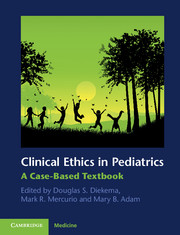Book contents
- Frontmatter
- Contents
- Contributors
- Preface
- Section 1 Core issues in clinical pediatric ethics
- Section 2 Ethical issues at the beginning of life: perinatology and neonatology
- 10 Maternal–fetal conflicts
- 11 Fetal intervention and fetal care centers
- 12 Ripped from the headlines: assisted reproductive technology and multiple births
- 13 Preimplantation and prenatal genetic testing for inherited diseases, dispositions, and traits
- 14 Decision-making in the delivery room
- 15 Withholding and withdrawing life-sustaining intervention from neonates
- 16 The role of quality of life assessments in neonatal care
- 17 Variations of practice in the care of extremely preterm infants
- Section 3 When a child dies: ethical issues at the end of life
- Section 4 Ethical issues posed by advances in medical technology and science
- Section 5 Children, public health, and justice
- Section 6 Special topics in pediatric ethics
- Index
- References
13 - Preimplantation and prenatal genetic testing for inherited diseases, dispositions, and traits
from Section 2 - Ethical issues at the beginning of life: perinatology and neonatology
Published online by Cambridge University Press: 07 October 2011
- Frontmatter
- Contents
- Contributors
- Preface
- Section 1 Core issues in clinical pediatric ethics
- Section 2 Ethical issues at the beginning of life: perinatology and neonatology
- 10 Maternal–fetal conflicts
- 11 Fetal intervention and fetal care centers
- 12 Ripped from the headlines: assisted reproductive technology and multiple births
- 13 Preimplantation and prenatal genetic testing for inherited diseases, dispositions, and traits
- 14 Decision-making in the delivery room
- 15 Withholding and withdrawing life-sustaining intervention from neonates
- 16 The role of quality of life assessments in neonatal care
- 17 Variations of practice in the care of extremely preterm infants
- Section 3 When a child dies: ethical issues at the end of life
- Section 4 Ethical issues posed by advances in medical technology and science
- Section 5 Children, public health, and justice
- Section 6 Special topics in pediatric ethics
- Index
- References
Summary
Case narrative
Jack Garrod is a 2-week-old infant who is new to your pediatric practice. Christina Garrod’s pregnancy was full term and uncomplicated. Although she is only 26 years of age, she and her husband pursued prenatal diagnosis early in the pregnancy through the analysis of fetal DNA circulating in her blood. The test was expensive but effective in providing the couple with a complete DNA sequence on Jack. The testing service provided an analysis of 65 genes associated with health conditions and screened the sample for copy number variants. It was revealed that Jack has a relative risk of colon cancer in adulthood of 2.2 and for type II diabetes of 1.8. Fortunately his relative risk for nicotine addiction is 0.6. However, the screen also detected copy number variants in four regions of the genome and these particular variants have not been characterized. Therefore, it is uncertain whether these will produce significant health problems. The Garrods decided not to terminate the pregnancy based on this information but are anxious and eager for you to assess the baby and manage his health based on this genetic information.
Prenatal diagnosis
This case is, of course, science fiction, but a similar story is likely to be within technical reach in the next decade. Prenatal diagnosis – available since the 1960s – enables couples to diagnose genetic or anatomic abnormalities in a fetus prior to birth. The purposes of prenatal diagnosis are to offer an informed choice about whether to continue the pregnancy, make appropriate preparations for a child with special needs or, rarely, to intervene prenatally with therapeutic measures. Prenatal ultrasound examination is now used routinely by most obstetricians to evaluate gestational age and fetal anatomy, although its efficacy in improving pregnancy outcomes remains controversial. Invasive measures like amniocentesis and chorionic villus sampling are conducted on a more selective basis. These are largely safe and effective tools but they leave some couples with difficult decisions about abortion if a significant abnormality is identified. To circumvent some of the ethical difficulties of prenatal diagnosis, preimplantation genetic diagnosis (PGD) was developed in the 1990s as in vitro fertilization (IVF) became more technically efficient and available. PGD involves the genetic analysis of embryos in vitro to enable a choice of which embryos to transfer into the uterus. Other prenatal diagnostic approaches, such as isolating fetal DNA from the maternal circulation, are actively being developed. The general trend over recent decades is for less invasive technologies to be used more broadly in pregnancy for an expanding list of conditions.
- Type
- Chapter
- Information
- Clinical Ethics in PediatricsA Case-Based Textbook, pp. 68 - 76Publisher: Cambridge University PressPrint publication year: 2011



